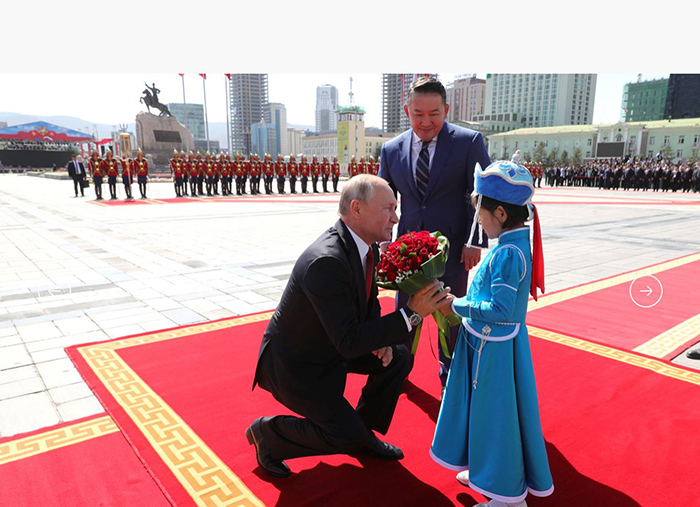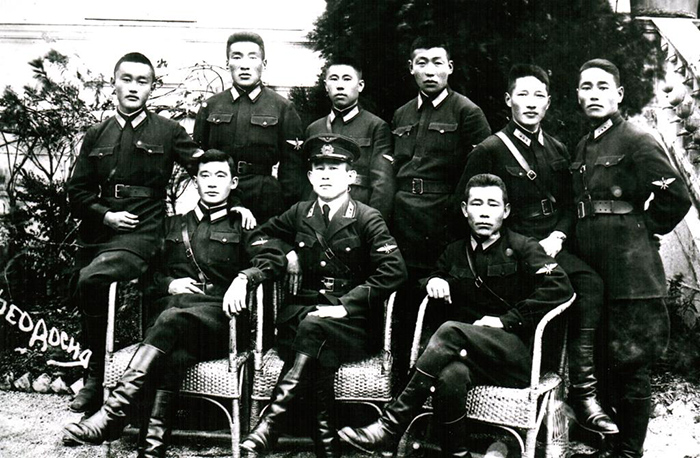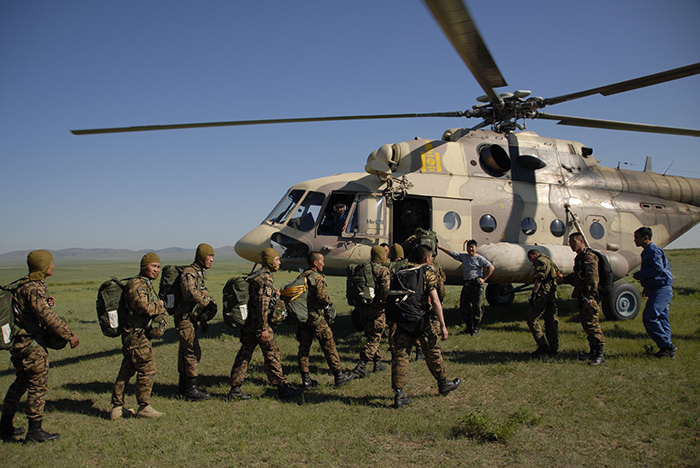The transfer of a pair of aircraft from the presence of the Ministry of Defence of the Russian Federation took place on November 26 at the territory of a military base located at the Genghis Khan international airport serving the capital of the country - the city of Ulan Bator. The event was timed to the celebration of the 95th anniversary of the proclamation of the Mongolian People's Republic (MPR). The fact is that a few years ago, due to exhaustion of resources and depreciation of the material, the last surviving MiG-21s were withdrawn from the Mongolian Air Force, and the country was left without fighter aircraft.

The transfer of a pair of aircraft from the presence of the Ministry of Defence of the Russian Federation took place on November 26 at the territory of a military base located at the Genghis Khan international airport serving the capital of the country - the city of Ulan Bator. The event was timed to the celebration of the 95th anniversary of the proclamation of the Mongolian People's Republic (MPR). The fact is that a few years ago, due to exhaustion of resources and depreciation of the material, the last surviving MiG-21s were withdrawn from the Mongolian Air Force, and the country was left without fighter aircraft.
Resources and Need
Mongolia is a poor country; limited financial resources prevent her from acquiring new combat vehicles. The annual defence spending is only about $120 million, for which you can buy ... one F-35 fighter! Having lost fraternal support after the collapse of the USSR, the Mongols turned to the Western states for military-technical assistance, hoping to get aircraft on credit or by instalments. However, in fact, it never came ...
Looking at the political map of the world, it is appropriate to ask the question: do the Mongols need combat aircraft in general, and fighters in particular?! After all, a small country in terms of population (just over three million inhabitants) does not have any significant resources to confront China or Russia, in the event of a hypothetical military conflict with one of two neighbouring superpowers. The national armed forces number less than ten thousand people, compared with the millions of armies of their neighbours ...
History remembers how during the Middle Ages hordes of Mongolian cavalry led by Genghis Khan (the most respected national military-political figure) defeated all foreign armies that stood in the way, establishing tight control over ancient China, Central Asia, Siberia, Kievan Rus, reaching central Europe. The descendants of the great warrior and the skilled politician for centuries held many subjugated peoples under their power. And in the last century, the Mongolian People’s Republic itself was attacked by the White Guards, Chinese and even ... Japanese militarists! So, as the ancient Romans said, Si vis pacem, para bellum - "if you want peace - get ready for war" ...
Permanent neutrality
Four years ago, the President of Mongolia declared "permanent neutrality" of his country. This, however, does not mean a refusal to maintain the Armed Forces. Moreover, Mongolian troops take part in peacekeeping missions around the world. In different years of the new millennium, they maintained public peace and order in Western Sahara, Sierra Leone, Liberia, Iraq, etc.
Today, counterterrorism operations come to the fore. Mongolian military personnel are familiar with them in Afghanistan, where some time ago, with the help of about twenty specialists, they trained local soldiers.

The national and religious composition of the population of Mongolia naturally excludes events like Afghan, Syrian or Iraqi. Meanwhile, recently among some young people there has been an increase in adherence to the Islamic traditions of their ancestral ancestors. As events in other countries show, terrorists often try to take advantage of this, directing interest in religious teachings in the desired direction, which is alarming and provides additional arguments for supporters of strengthening the combat effectiveness of the Mongolian Armed Forces.
Mongolian Air Force
Russian-Mongolian relations have deep historical roots, based on which good-neighbourly relations between the two peoples develop. For decades, Russia participated in the construction of the Armed Forces of Mongolia and the training of national personnel. The starting point for the creation of MNR aviation was the arrival, in the spring of 1925, to Ulan Bator, of three transport aircraft of the Junkers U-13 type. “Since that time, our young pilots, led by Soviet instructors, have mastered the piloting of such aircraft as the Yu-13, Il-2, R-1, R-5, U-2 (Po-2) and Yak-7. They were to participate in global regional conflicts, during which they honourably fulfilled their duty to protect the independence and territorial integrity of Mongolia. ” In 1931, the Soviet Union transferred the first batch of three combat aircraft to the Armed Forces of Mongolia. The additional aircraft that came after it made it possible to form the Sukhe-Bator aviation detachment.
The middle of the last century was marked by the formation of the first military units, technical and personnel of the Air Forces of the Armed Forces of Mongolia. “Among the Mongol pilots appeared great masters of their craft. Thanks to their efforts, Mongolian aviation has been steadily developing and moving towards new achievements.
In 1970, a MiG-17 fighter squadron was created. And between 1977 and 1984. a squadron of fighter-bomber aviation was formed, consisting of the most modern supersonic fighters MiG-21PF and MiG-21UM at that time. These squadrons made over ninety thousand sorties. ”
More recently, Mongolia was one of the few countries in the world whose envoys traveled to outer space ”(Zhugderdemidiin Gurragcha made a space flight on March 22-30, 1981, as part of the Soyuz-39 crew).
Recently, the scope of military-technical cooperation between the two countries has been expanding again, the number of visits and negotiations at the highest level is increasing. The first of the senior Russian military commanders last year was visited by Mongolian Defence Minister General of the Army Sergei Kuzhugetovich Shoigu in Mongolia. And in September, the official visit of the President of Russia Vladimir Vladimirovich Putin followed. He launched the implementation of a major construction project in the Khalkhin-Gol region of East Aimak.
Putin's visit
As noted above, the transfer of the MiG-29UB pair last month from the presence of the Ministry of Defence of the Russian Federation was carried out at the direction of the Supreme Commander-in-Chief of the Armed Forces of Russia. The corresponding decision was made following the results of the visit of the Head of State to Mongolia on September 2-3 of this year. As if anticipating this event, President Khaltmagiin Battulga then said: “As Commander-in-Chief of the Armed Forces of Mongolia, I am glad that the Russian Federation pays great attention to development and cooperation in the defence field and military-technical cooperation, provides free technical assistance and is constantly trained our military experts."

State to Mongolia on September 2-3 of this year. As if anticipating this event, President Khaltmagiin Battulga then said: “As Commander-in-Chief of the Armed Forces of Mongolia, I am glad that the Russian Federation pays great attention to development and cooperation in the defence field and military-technical cooperation, provides free technical assistance and is constantly trained our military experts."
Vladimir Putin flew to Ulaanbaatar in the evening of September 2, and held meetings with the leaders of the host country the whole next day. He was received by President Khaltmagiin Battulga, Prime Minister Uhnagiin Hurelsuh and Chairman of the Great State Khural Gombozhavyn Zandanshatar. Between the two countries ten documents were signed, including the intergovernmental protocol on the renewal of the 2004 agreement on the provision of military-technical assistance to Mongolia at no cost. Actually, on the basis of this document, the transfer of two MiGs took place.
In addition, during the September visit, the parties entered into an indefinite agreement on friendly relations and a comprehensive strategic partnership between Mongolia and the Russian Federation. It is drawn up on the basis of the Treaty on Friendly Relations and Cooperation of 1993 and, as it were, goes into its development. According to the leader of the host country, the new agreement represents the fundamental text, which “spells out the basic principles of our relations,” so the signing of this document brought our relations to a qualitatively new level, “strengthened mutual trust and prepared the basis for expanding mutually beneficial cooperation.” Thus, we demonstrated a mutual desire to bring our interaction to a higher level and jointly solve large-scale long-term tasks.
Festive events
Senior officials of the two countries took part in celebrations dedicated to the 80th anniversary of the victory of the Soviet and Mongolian troops in the battles at Khalkhin Gol. These included demonstrations by pilots from Kubinka near Moscow on Su-30SM aircraft and a concert by the Song and Dance Ensemble of the Russian Army named after Alexandrov. The participation of Russian envoys embellished the celebration and added solemnity to it. Vladimir Putin and Khaltmagiin Battulga laid wreaths at the monuments, talked with veterans, visited a thematic art exhibition and spoke at a gala reception on the occasion of memorable events of military glory.
President Battulga noted: “The Mongolian people are glad that we are celebrating this anniversary so solemnly and widely” and that he “very positively accepted” the demonstration performance of “Russian Knights”. Mongolian-Russian relations have been tested by historical traditions, military partnership and time, and are developing on the principles of mutual trust, he stressed.

“We are grateful that the President of the Russian Federation, on an official visit, together with us celebrates the 80th anniversary of victory in the battles at Khalkhin Gol. This victory, which defended our independence and sovereignty, welded together the friendship between our peoples, is sacred to us. <...> In 1939, in a short time, a large number of military personnel, aircraft, tanks, military equipment and weapons were delivered at a great distance, and large-scale battles were fought in a relatively small area. Thus, the fighting on Khalkhin Gol is of particular importance in world military history. In no case should there be attempts to falsify the true causes and significance of this war. Somon Khalkhin-Gol of the eastern aimak became the largest battlefield and a hotbed of historical victory. ”
Tugriks on fighters
For his part, Putin also attached great importance to the events of the middle of the last century. “In 1939, Soviet and Mongolian soldiers, fighting shoulder to shoulder, fiercely rebuffed the aggressor and together defended the sovereignty and territorial integrity of Mongolia. The victory achieved cooled the militant ardor of the invaders, guaranteed the safety of the Far Eastern borders of the Soviet Union during the difficult years of the Great Patriotic War. ”
“Of course, we well remember the significant support that the Mongolian friends and the Mongolian people rendered to our country in the fight against fascism, not to mention the supply of about five hundred thousand horses, which was extremely important for those times. 53 tanks were built on donations collected by Mongolian citizens. These tanks, united in the tank brigade "Revolutionary Mongolia", entered their first battle in 1943 on the Kursk, and in 1945 among the first entered Berlin. The Mongolian Arat air squadron also took part in the battles on the war fronts. The fighters included in it were also presented to the Soviet Union by Mongolia. ”
According to the Supreme Commander-in-Chief, the interaction of our countries in the area of military equipment and aviation was not "one-way traffic." When Mongolia needed help with equipment and troops, Moscow provided it, and in the difficult time of the struggle against German Nazism, the Mongols sent us horses, cattle, fur clothes, food, raised money to support the military-industrial complex, including aviation production. The Mongolian Arat squadron mentioned by Vladimir Vladimirovich was formed in the spring and summer of 1943 on La-5 fighters built on voluntary donations from the Mongolian people - about two million Tugriks.
The first Mongolian aviators
The starting point for the permanent deployment of aircraft in Mongolia was the arrival, on May 25, 1925, in Ulan Bator, of three U-13 aircraft (Soviet designation) with crews. We are talking about Junkers F.13 - single-engine monoplanes with a crew of two people, capable of carrying up to four passengers.
Soon, Soviet pilots organised the postal service of the capital of Mongolia with remote territories and began to train local personnel. Learning from the experience of the envoys of the Country of Soviets, the Mongolian pilots from 1927 began flying with crews, and then - independent sorties. And three years later, the first group of natives of Mongolia went to the Soviet Union to master the profession of military pilots. Among them were the future Heroes of the MPR Damchaagiin Dembarel and Choimbolyn Shagdasuren.

Damberel and Shagdasasuren
A serious reason for the strengthening of Mongolian aviation was the seizure of Manchuria by the Japanese troops, with its subsequent withdrawal from the protectorate of the central government of China and the formation of the puppet state "Manzhou-go." In the summer of 1931, the MPR received, as a gift from the Soviet government, several R-5 aircraft with machine gun weapons. They served as the basis for the formation of the Suche-Bator squadron.
It was the single-engine biplanes of the R-5 family of aircraft designer Nikolai Nikolayevich Polikarpov that for a long time formed the basis of Mongolian aviation. The mass of the aircraft was about two tons, flight weight - from 3000 to 3800 kg. In addition to reconnaissance, postal and transport (up to four passengers), the aircraft was also produced in the version of the light attack aircraft R-5Sh (LSH-5). In addition to a pair of machine guns to protect the rear hemisphere, he was armed with four PV-1 or ShKAS mounted in pairs under the lower wing consoles for firing ahead on the course.
The aircraft could, depending on the power of the installed engine (M-17, AM-34), carry from 240 to 500 kg of payload. In practice, the attack aircraft used light fragmentation bombs, placing them on eight nodes of the hinge under the lower wing. By the standards of the first half of the thirties, the base R-5 seemed to be a good reconnaissance, and the R-5Sh - a fairly powerful direct fire support aircraft. In Mongolian aviation, they tried to use them mainly in collaboration with cavalry divisions.
Combat use
Not recognising the MPR and preparing for further penetration to the north, the Japanese provoked an armed rebellion against the central government in Ulan Bator. The squadron R-5 helped to suppress it, during the ten days of August-September 1934 it completed about thirty sorties. The general command was carried out by the future Air Marshal Vladimir Aleksandrovich Sudets, and three Soviet and two Mongolian pilots directly performed combat missions.
The next combat use dates back to March 1935. The squadron on the biplanes R-5 and U-2 was relocated from Ulan Bator to the front airfield "Tamtsak-Bulak". Using also Matad and Bain-Tumen, aviators patrolled the disputed section of the border in the area of Lake Buir-Nur (Buir-Nuur). If necessary, they provided fire support to border guards in repelling armed provocations. Sometimes, planes performed several sorties daily, dropping bombs and firing machine guns. Here, the Mongolian aircraft suffered the first combat losses - two R-5 aircraft.
The first air parade over Ulan Bator took place in 1936 with the participation of eight aircraft. And after a couple of years, the Mongolian fleet grew to forty-five cars. The commander of the first air regiment in 1938 was a military pilot with combat experience Choimbolyn Shagdasuren. Due to the lack of local personnel (at that time there were 27 Mongol pilots), the crews basically continued to be mixed. Among the Soviet pilots are mentioned: Andrianov, Mann, Mironov, Novoseltsev, Pavlov, Polushin, Reifshneider, Starostenko, Sudnik, Fil, Khazakhmetov and Cherenkov.
The Mongolian squadron on seven aircraft was involved in the battle at Khalkhin Gol. Due to the superiority of Japanese fighter aircraft in May 1939, the P-5 suffered unjustified losses and left the combat zone. In the summer, in preparation for the counteroffensive, they were returned, changing the tactics of action.

1941, Mongolian graduates of the aviation school in Borisoglebsk
Now, under the command of the Mongolian commander Bohr, low-speed biplanes flew from the Matad airfield only in the dark, using the "jump" airfields at the front line. The R-5 crews were able to reach the target with light signals from positions at the front line. The main task was not to give the Japanese soldiers peace even at night, exhausting them with bombardments from heights of the order of three kilometres - outside the zone of destruction of small arms and anti-aircraft guns of caliber up to 20 mm.
Note that the Japanese army aviation on the theatre almost did not fly at night due to the lack of a sufficient number of pilots with appropriate training. With the instrument cabin equipment of the time, it was really a difficult and dangerous business, requiring high flying skill and knowledge of the terrain.
In total, during the battle on Khalkhin Gol, the crews of the Mongolian air squadron completed 186 sorties and dropped about sixty tons of bombs, losing one car due to a navigation error. Performing night flights, Hamza Yerzinuly (Mudaris) Zaisanov distinguished himself - an ethnic Kazakh who lived in Mongolia. A graduate of the Orenburg flight school, he commanded the Mongolian aviation regiment, and in 1942 he headed the entire military aviation of the country.
After the ceasefire in September 1939, there were only a few episodes of the use of Mongolian aviation on the border with Manzhou-Guo and areas of China under the control of the Kuomintang. There is no information about her participation in the defeat by the Soviet troops of the Kwantung Army in 1945.
Post-war period
Shortly after the war, the MPR government established a civil aviation service for air communications with remote aimaks. Then it served as the basis for the creation of the national airline MIAT - Mongolian Airlines. The fleet of its aircraft was consistently replenished with An-2, Il-14, An-24 and An-26 aircraft. In the late seventies, MIAT mastered its first jet airliner - Tu-154. Today, its fleet consists of the Boeing 737 and 767, and the arrival of the Boeing 787-9 Dreamliner is expected in 2021.
Military aircraft also did not stand still. Biplanes with piston engines gave way to monoplanes with turboprop and turbojet engines. As of 2008, the number of Air Forces was estimated at about eight hundred people, including anti-aircraft missile and artillery units. Today, An-26 military transport aircraft, Mi-24 fire support helicopters and Mi-8 military transport aircraft are in service.

For a long time on the territory of the MPR there was an impressive group of Soviet troops, including aviation and anti-aircraft missile units. With its withdrawal in 1989-1992. a large number of equipment and equipment were handed over to the local military. There was even a certain oversupply, exacerbated by reductions in the national armed forces and a reduction in real military spending.
When the stocks were thinned, the government formed on democratic principles (after the so-called "Democratic Revolution of 1992") turned to the United States, Turkey and other Western countries for military assistance. This turns out to be, but in an extremely limited amount, mainly through the training of military leaders and the supply of so-called "Non-combat materials." It practically had no effect on the state of the Air Force park.
The signing of new agreements with Russia in the fall of 2019, including the intergovernmental protocol on the renewal of the 2004 agreement to provide Mongolia with military-technical assistance at no cost, provides the basis for a new impetus in the development of the country's military aviation. Perhaps a pair of MiGs received in November will be the first step in this direction.











